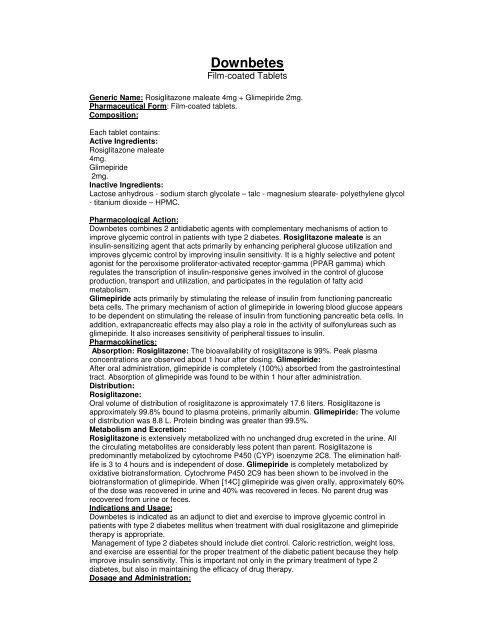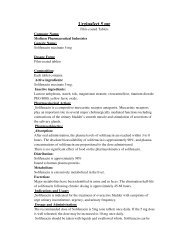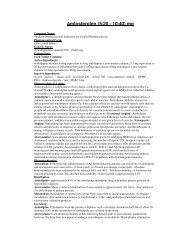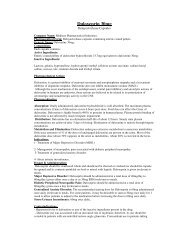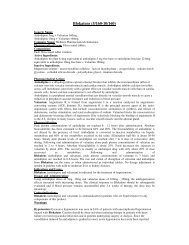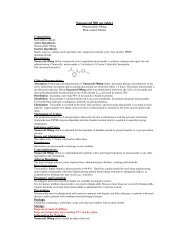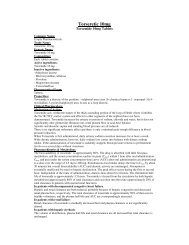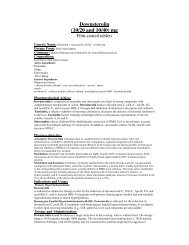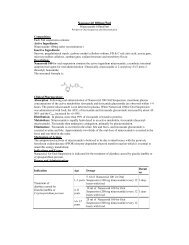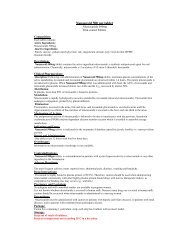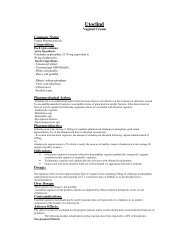Downbetes - Utopia Pharmaceuticals
Downbetes - Utopia Pharmaceuticals
Downbetes - Utopia Pharmaceuticals
- No tags were found...
You also want an ePaper? Increase the reach of your titles
YUMPU automatically turns print PDFs into web optimized ePapers that Google loves.
<strong>Downbetes</strong>Film-coated TabletsGeneric Name: Rosiglitazone maleate 4mg + Glimepiride 2mg.Pharmaceutical Form: Film-coated tablets.Composition:Each tablet contains:Active Ingredients:Rosiglitazone maleate4mg.Glimepiride2mg.Inactive Ingredients:Lactose anhydrous - sodium starch glycolate – talc - magnesium stearate- polyethylene glycol- titanium dioxide – HPMC.Pharmacological Action:<strong>Downbetes</strong> combines 2 antidiabetic agents with complementary mechanisms of action toimprove glycemic control in patients with type 2 diabetes. Rosiglitazone maleate is aninsulin-sensitizing agent that acts primarily by enhancing peripheral glucose utilization andimproves glycemic control by improving insulin sensitivity. It is a highly selective and potentagonist for the peroxisome proliferator-activated receptor-gamma (PPAR gamma) whichregulates the transcription of insulin-responsive genes involved in the control of glucoseproduction, transport and utilization, and participates in the regulation of fatty acidmetabolism.Glimepiride acts primarily by stimulating the release of insulin from functioning pancreaticbeta cells. The primary mechanism of action of glimepiride in lowering blood glucose appearsto be dependent on stimulating the release of insulin from functioning pancreatic beta cells. Inaddition, extrapancreatic effects may also play a role in the activity of sulfonylureas such asglimepiride. It also increases sensitivity of peripheral tissues to insulin.Pharmacokinetics:Absorption: Rosiglitazone: The bioavailability of rosiglitazone is 99%. Peak plasmaconcentrations are observed about 1 hour after dosing. Glimepiride:After oral administration, glimepiride is completely (100%) absorbed from the gastrointestinaltract. Absorption of glimepiride was found to be within 1 hour after administration.Distribution:Rosiglitazone:Oral volume of distribution of rosiglitazone is approximately 17.6 liters. Rosiglitazone isapproximately 99.8% bound to plasma proteins, primarily albumin. Glimepiride: The volumeof distribution was 8.8 L. Protein binding was greater than 99.5%.Metabolism and Excretion:Rosiglitazone is extensively metabolized with no unchanged drug excreted in the urine. Allthe circulating metabolites are considerably less potent than parent. Rosiglitazone ispredominantly metabolized by cytochrome P450 (CYP) isoenzyme 2C8. The elimination halflifeis 3 to 4 hours and is independent of dose. Glimepiride is completely metabolized byoxidative biotransformation. Cytochrome P450 2C9 has been shown to be involved in thebiotransformation of glimepiride. When [14C] glimepiride was given orally, approximately 60%of the dose was recovered in urine and 40% was recovered in feces. No parent drug wasrecovered from urine or feces.Indications and Usage:<strong>Downbetes</strong> is indicated as an adjunct to diet and exercise to improve glycemic control inpatients with type 2 diabetes mellitus when treatment with dual rosiglitazone and glimepiridetherapy is appropriate.Management of type 2 diabetes should include diet control. Caloric restriction, weight loss,and exercise are essential for the proper treatment of the diabetic patient because they helpimprove insulin sensitivity. This is important not only in the primary treatment of type 2diabetes, but also in maintaining the efficacy of drug therapy.Dosage and Administration:
<strong>Downbetes</strong> should be given once daily with the first meal of the day. If a dose is forgotten, thefollowing dose must not be doubled.Starting Dose: The recommended starting dose is 4 mg/2 mg administered once daily withthe first meal of the day. For patients already treated with a sulfonylurea or athiazolidinedione.Dose Titration:• Dose increases should be individualized according to the glycemic response of thepatient.• If hypoglycemia occurs during up-titration of the dose or while maintained on therapy,a dosage reduction of the glimepiride component of <strong>Downbetes</strong> may be considered.• For patients previously treated with sulfonylurea monotherapy and switched to<strong>Downbetes</strong>, it may take 2 weeks to see a reduction in blood glucose and 2 to 3months to see the full effect of the rosiglitazone component. Therefore, dose titrationof the rosiglitazone component of <strong>Downbetes</strong> is recommended if patients are notadequately controlled after 8 to 12 weeks. Patients should be observed carefully (1 to2 weeks) for hypoglycemia when being transferred from longer half-life sulfonylureas(e.g., chlorpropamide) to <strong>Downbetes</strong> due to potential overlapping of drug effect.• After an increase in the dosage of the rosiglitazone component, dose titration isrecommended if patients are not adequately controlled after 2 to 3 months.• The maximum recommended daily dose is 8 mg rosiglitazone/4 mg glimepiride.Contraindications:<strong>Downbetes</strong> is contraindicated in patients with hypersensitivity to rosiglitazone or glimepiride orany other ingredient in the formulation. In case of diabetic ketoacidosis with or without coma,the condition should be treated with insulin.Adverse Reactions:- Headache, nasopharyngitis, hypertension and hypoglycemia were observed in (5%) of thepatients treated with <strong>Downbetes</strong>. Edema was reported by 3.2% of patients and congestiveheart failure was observed in (0.2%) of patients.- The most common adverse experiences with rosiglitazone monotherapy (5%) were upperrespiratory tract infections, injury, headache, anemia and edema.- The incidence of hypoglycemia with glimepiride occurred in more than 1% of patients;dizziness (1.7%), asthenia (1.6%), headache (1.5%) and nausea (1.1%). Vomiting,gastrointestinal pain and diarrhea were less than 1%. Allergic skin reactions e.g. pruritus,erythema, urticaria, porphyria cutanea tarda, photosensitivity reactions and allergic vasculitisoccured in less than 1% of treated patients. Leukopenia, agranulocytosis, thrombocytopenia,hemolytic anemia, aplastic anemia, pancytopenia, hepatic porphyria reactions and disulfiramlikereactions have also been reported. Cases of hyponatremia and sulfonylureas mayaugment the peripheral (antidiuretic) action of ADH and/or increase release of ADH.- Changes in accommodation and/or blurred vision may occur with the use of glimepiride.- Pediatric Use: Safety and effectiveness in pediatric patients have not been established.Drug Interactions:Drugs that Inhibit, Induce or are Metabolized by Cytochrome P450:An inhibitor (such as gemfibrozil) may decrease the metabolism of rosiglitazone and aninducer (such as rifampin) may increase the metabolism of rosiglitazone.Digoxin:Repeated oral dosing of rosiglitazone (8 mg once daily) for 14 days did not affect digoxin(0.375 mg once daily). Warfarin: Repeated dosing with rosiglitazone had no effect onwarfarin.Glimepiride: The hypoglycemic action of sulfonylureas may be potentiated by certain drugsincluding nonsteroidal anti-inflammatory drugs (NSAIDs) and other drugs that are highlyprotein bound such as salicylates, sulfonamides, chloramphenicol, coumarins, probenecid,monoamine oxidase inhibitors and beta-adrenergic blocking agents. When these drugs areadministered to a patient receiving glimepiride, the patient should be observed closely forhypoglycemia. Certain drugs tend to produce hyperglycemia and may lead to loss of control.These drugs include thiazides and other diuretics, corticosteroids, phenothiazines, thyroidproducts, estrogens, oral contraceptives, phenytoin, nicotinic acid, sympathomimetics andisoniazid. When these drugs are administered to a patient receiving glimepiride, the patientshould be observed closely for hypoglycemia.


